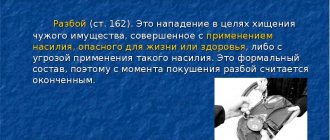Every resident of the country needs to know the basic aspects of criminal law. Such types of theft as robbery (Article 162, Chapter 21 of the Criminal Code of the Russian Federation), theft (Article 158, Chapter 21 of the Criminal Code of the Russian Federation), and robbery (Article 161, Chapter 21 of the Criminal Code of the Russian Federation) are known to everyone. However, not each of us distinguishes between these types of crimes.
Yes, they are all placed in one chapter of the Criminal Code of the Russian Federation - “Crimes against property” (Chapter 21 of the Criminal Code of the Russian Federation) and are united by one goal - the illegal gratuitous seizure of someone else’s property without the subsequent return of the item to its owner. But each of these crimes has a lot of features - let's look at them in detail.
Secret theft of someone else's property - theft
According to Article 158 of the Criminal Code of the Russian Federation, theft is the secret theft of someone else's property. The peculiarity of theft is that the thing is seized in the absence of its owner and without any witnesses OR if the offender was noticed by the owner or witnesses, but believed that the crime would go unnoticed.
For example, if his actions were filmed on a hidden camera or were noticed by neighbors from the window. A crime is also called theft if it occurs in the presence of witnesses or the owner of the thing , but they are unaware of the evil intention of the criminal. For example, if a visiting guest turns out to be a criminal who stole property in the house.
Open appropriation - robbery
According to Article 161 of the Criminal Code of the Russian Federation, robbery is the open theft of someone else's property. This type of crime against property is committed in the presence of the owner of the property or strangers who take measures to suppress the crime or are simply witnesses.
The main condition is that those present must understand the illegality of the action. Robbery differs from robbery by the use of violence, which does not threaten the life or health of the victim or its complete absence.
Advice from a lawyer on how to reclassify an act during the investigation and in court
As practice shows, when sending a criminal case to court, the investigator often classifies the crime “with reserve”, that is, under a more serious article for certain reasons:
- Traditionally, the effectiveness of law enforcement agencies is assessed by the number of serious crimes solved and sent to court. The investigator, as a rule, is not interested in what qualifications will be indicated in the verdict.
- Since the deterioration of the defendant’s position during the consideration of the case in court is not allowed, if the qualifications are dubious, the investigator will always act on the principle of “better more than less” and send the case to the court with qualification under a more serious article in the hope that “the court will correct it.”
Reclassification of the case during the investigation seems more problematic, but it is possible.
As a rule, in borderline cases, much depends on the testimony of the defendant himself, since only he can explain the details of his intent, if, of course, he admits guilt.
If the criminal’s intent included committing theft, and the charge was brought for robbery, then it makes sense to admit partial guilt during the investigation. During interrogation as an accused, you should explain your position and, if necessary, submit a request for investigative actions to support it. Let's look at an example.
The young man is accused of committing robbery under the following circumstances. Early in the morning he entered the cafe through a broken window. Having put some gourmet foodstuffs into his bag, he heard the key turn in the lock - the first cook had come to replace him.
The thief quickly climbed out through the window and started running. A cafe employee, turning on the light, saw the chaos, ran to the window, and, noticing a running thief in the distance, began shouting to him to return the stolen goods. According to the cook, he heard him, but still disappeared. Based on this testimony, a charge of committing open theft - robbery was brought.
During the investigation, the accused partially admitted his guilt and testified that he did not hear the cook’s screams and committed theft, that is, secret theft. The lawyer filed a petition to conduct an investigative experiment, during which it turned out that at such a distance the defendant could not hear the cook’s screams. The result was requalification from Art. 161 at station 158 part 2, that is, theft by entering the premises.
During the trial, reclassification to a less serious charge is also possible.
For example, the court heard a case of robbery committed by a group of young people under the following circumstances.
Several college students, being avid fans, attended the football game. After it was over, they met a fan of the opposing team, and a verbal altercation ensued between them, which escalated into a fight. The parties tried to prove to each other with their fists which football team deserved victory more.
The fight was not serious, they wrestled, pushed each other, and separated. After the conflict, a lone fan did not find a cell phone in his jacket pocket. This phone was subsequently seized from one of the college students involved in the conflict. It turned out that the victim took off his jacket before the fight, and one of the attackers pulled out a phone from his pocket. The case was sent to court under Art. 161 part 2, as robbery with the use of violence by a group of persons.
In court, the students' lawyers developed a unified position based on the fact that the cause of the conflict and fight was opposing opinions about football teams. During the fight, no demands were made on the victim; the phone was secretly stolen by one of the company members, who did not inform the others about it.
Violence during a fight was not a means of taking possession of property, which is what distinguishes robbery from theft.
This version was fully confirmed during the judicial investigation. The thief stated that when he saw the jacket lying there, he decided to check his pockets and found a phone. He took the phone for himself without informing others about it, thus committing a secret theft, that is, theft.
As a result, the verdict against him was made under Art. 158 part 2, the remaining participants in the incident were acquitted under Art. 161 part 2, although their actions contained elements of another crime - beatings.
Answering the question: “Theft and theft of other types - what is the difference?” — it is necessary to pay special attention to the intent of the perpetrator, which will help to avoid erroneous classification. .
How are they different from each other?
The distinction should be made based on the following characteristics.
| Theft | Robbery | Robbery | |
| Having a desire to remain unnoticed | the criminal wants to remain undetected | the criminal's actions are carried out openly and with complete disregard for their illegality | the criminal also commits acts openly |
| Use of violence | violence is not used in any form | violence is either absent or used without threat to the life and health of the victim | the use of violence is mandatory |
| Level of responsibility | punishable by imprisonment for a term of up to five years or compulsory labor for a term of up to 480 hours and a fine | punishable by forced labor for a term of up to five years or imprisonment for a term of up to five years and a fine | punishable by imprisonment for up to ten years and a fine |
Main differences between criminal acts
The ability to distinguish between different crimes is extremely important for an investigator or other law enforcement official.
This need is due to the fact that different types of criminal acts have different punishments. Let's look at what the main difference between robbery and robbery is, and for this we will highlight the following points:
| Criteria for highlighting differences | Robbery | Robbery |
| The crime poses a public danger | A “misdemeanor” is committed in a way that is not dangerous to the well-being and life of citizens. | Threats and violence are used against the victim. |
| Presence of intent in the crime | Taking possession of someone else's property occurs with intent, but the perpetrator does not use violence. | A person deliberately uses violent methods. |
| The consequences of crime are dangerous for society | A person gets the opportunity to take someone else’s thing, and only after performing this action will the crime be considered completed. | An act may have a truncated composition when it does not matter whether the criminal completed his action and received the opportunity to take possession of the property. |
| Method of committing the crime | The act is classified as robbery if there was no weapon or the threat was made with a “fake” weapon. | During the theft, obviously dangerous objects were used, i.e. weapons or items equivalent to them. |
Based on the listed signs and characteristics, you can easily determine what form of criminal act we are talking about. You can also use examples from judicial practice. Additional information about the differences between the two types of crimes described is presented in the video:
Composition of theft
The object of the crime is social relations that develop in the sphere of distribution and redistribution of material goods and belong to the category of “property”. Theft does not entail the loss of the owner's right to the property seized from him during the crime, and the person who committed the theft does not have the right of ownership to the stolen property. Any form of disposal of stolen goods is illegal.
The subject of the crime is a sane individual who has reached the age of 14 (how the crime is classified and what is the responsibility for it if the theft is committed by a person under 14 years of age, read here).
The subject of theft is someone else's property.
The purpose of the crime is the action of the perpetrator for the gratuitous and deliberately unlawful appropriation of someone else’s property.
The intent is self-interest.
The motive is direct.
The objective side of the crime is the actions of the perpetrator in the material world, aimed at confiscating someone else’s property and turning it into one’s own benefit or the benefit of other persons.
Theft is considered secret if:
- it is carried out in the absence of the owner of the property and/or unauthorized persons;
- it is performed in the presence of the owner and/or unauthorized persons, but unnoticed by them;
- the owner or other persons saw the crime being committed, but the offender believed that his actions were invisible;
- it is committed in the presence of people who cannot realize the illegality of the action due to any circumstances (mentally ill, sleeping, children, heavily drunk, fainting);
- it is committed in the presence of relatives or loved ones of the criminal, who are aware of the illegality of the action, but the criminal believes that they will not oppose him.
Consequence : causing property damage to the victim.
Subjective side of the crime : guilt in the form of direct intent and selfish purpose.
Construction of the crime : material composition.
The crime is considered completed when the perpetrator has stolen someone else's property and has a real opportunity to use it and dispose of it as he wishes.
For more information about the elements of the crime, as well as what factors are considered as objective and subjective signs of theft, read this material.
Example
The criminal quietly entered the apartment of an elderly woman at night while she was sleeping and stole valuable documents and jewelry. He appropriated the woman’s property and went unnoticed - the crime took place.
What to do in such situations, if your documents were stolen, you will learn from this material.
Responsibility
Theft without qualifying characteristics is punishable (according to Part 1 of Article 158 of the Criminal Code of the Russian Federation):
- a fine in the amount of up to eighty thousand rubles or in the amount of the wages or other income of the convicted person for a period of up to six months;
- or compulsory work for a period of up to three hundred and sixty hours;
- or correctional labor for up to one year;
- or restriction of freedom for a term of up to two years;
- or forced labor for up to two years;
- or arrest for up to four months;
- or imprisonment for a term of up to two years.
The first group of qualifying signs of theft includes:
- commission of a crime by a group of persons by prior conspiracy;
- committing a crime involving illegal entry into a premises or other storage facility;
- commission of a crime causing significant damage to the victim;
- committing theft from a bag or other carry-on luggage that was with the victim, from clothing (you can learn more about pickpocketing here).
These types of theft are punishable (according to Part 2 of Article 158 of the Criminal Code of the Russian Federation):
- a fine in the amount of up to two hundred thousand rubles or in the amount of wages or other income of the convicted person for a period of up to eighteen months;
- or compulsory work for a period of up to four hundred eighty hours;
- or correctional labor for up to two years;
- or forced labor for up to five years with or without restriction of freedom for up to one year;
- or imprisonment for a term of up to five years with or without restriction of freedom for a term of up to one year.
The following qualifying signs of theft include:
- committing theft with illegal entry into a home;
- committing theft from an oil pipeline, oil product pipeline, gas pipeline;
- committing grand theft;
- committing theft from a bank account;
- committing theft in relation to electronic funds.
In this case, theft is punishable (according to Part 3 of Article 158 of the Criminal Code of the Russian Federation):
- a fine in the amount of one hundred thousand to five hundred thousand rubles or in the amount of wages or other income of the convicted person for a period of one to three years;
- or forced labor for a period of up to five years with or without restriction of freedom for a period of up to one and a half years;
- or imprisonment for a term of up to six years with a fine of up to eighty thousand rubles;
- or in the amount of wages or other income of the convicted person for a period of up to six months or without it and with restriction of freedom for a period of up to one and a half years or without it.
Qualifying signs of theft also include:
- committing theft by a group;
- committing theft on an especially large scale.
These types of theft are punishable (according to Part 4 of Article 158 of the Criminal Code of the Russian Federation):
- imprisonment for a term of up to ten years with a fine of up to one million rubles;
- or in the amount of wages or other income of the convicted person for a period of up to five years or without it and with restriction of freedom for a period of up to two years or without it.
We tell you more about what punishment for theft is provided for under Article 158 of the Criminal Code of the Russian Federation in a special article.
Types of crime
A crime such as robbery is classified mainly by the degree of cruelty, the number and age of persons who participated in the crime, and the presence of weapons. When considering a case, all these factors are taken into account using a differentiated method, depending on the conditions and characteristics of the actions. Let's look at the most common types of robbery:
- Property. This type of robbery, in terms of severity, is the most loyal to the victim. It is he who is considered basic in legal practice. It is worth noting that property robbery does not imply any physical violence against the victim and is exclusively enriching in nature.
- Armed. Robbery with the use of a weapon is qualified even if it was not used in the attack. Judicial practice stipulates that the presence of weapons implies that the criminals planned the attack taking into account their possible use. In addition, any object that could have caused injury to the victim is also considered a weapon (bottles, pipes, stones, etc.).
- With penetration. A significant aggravation of the robbery itself is the fact that criminals enter private territory. Accordingly, they suffer harsher punishment.
Separately, it is necessary to consider the subcategory of robbery with murder. Such crimes are considered the most cruel and are punishable by the highest degree of punishment provided for by law. Depending on the conditions under which the crime was committed, the following types are distinguished:
- On the roads. This type of robbery is most often committed with the aim of stealing funds in the possession of the driver or the vehicle itself.
- By a group of persons by prior conspiracy. It is this type of crime that is most often associated with the murder of the victim. In such cases, the use of weapons, as well as the absence of them, is possible.
- Nautical. As a rule, this type of robbery involves not only fairly large thefts, but also a disruption in the regular operation of shipping routes. Accordingly, all this is taken into account in court when passing a sentence.
Thus, robbery covers a fairly wide range of various illegal actions, which somewhat complicates the procedure for its qualification.
Be sure to indicate in the claim all the details that were noticed by you during the attack on you (implying robbery). This will ensure that the offender receives the full punishment, and will also simplify the procedure for considering the case.
Composition of robbery
The object of the crime is social relations that develop in the sphere of distribution and redistribution of material goods and belong to the category of “property”. Robbery is characterized by a complex object, since the attack is carried out not only on relations related to the distribution and redistribution of material goods, but also on the health of the victim.
The subject of the crime is a sane person who has reached the age of 14 and does not have any authority in relation to the stolen property.
The subject of robbery is someone else's property.
The purpose of robbery is the gratuitous seizure of someone else's property for one's own benefit.
The intent is self-interest.
The motive is direct.
The objective side of the crime is the open illegal seizure of property in the presence of the owner or owner, as well as strangers, when the person committing this crime is aware that those present understand the illegal nature of his actions, regardless of whether they took measures to suppress these action or not.
The consequence is causing property damage to the property owner.
The subjective side of the crime is direct intent and selfish purpose.
Construction of the crime - the material elements of the crime.
The crime is considered completed when the criminal has taken possession of someone else’s property and acquired a real opportunity (albeit not legal) to dispose and use the property or destroy it.
Life situation
The criminal approached a passerby, snatched the mobile phone from his hands and ran away. We see that the criminal understands the illegality of his actions and understands that the victim will know about the robbery, that is, the crime will occur in front of the victim.
What to do and where to go if in life you encounter the situation discussed in the example and your mobile phone is stolen, we will tell you in a separate article.
Amount of punishment
Robbery without qualifying characteristics is punishable (according to Part 1 of Article 161 of the Criminal Code of the Russian Federation):
- compulsory work for a period of up to four hundred eighty hours;
- or correctional labor for up to two years;
- or restriction of freedom for a term of two to four years;
- or forced labor for up to four years;
- or arrest for a term of up to six months, or imprisonment for a term of up to four years.
Qualifying features:
- commission of a crime by a group of persons by prior agreement;
- committing a crime with illegal entry into a home, premises or other storage;
- committing a crime with the use of violence that is not dangerous to life and health or with the threat of violence;
- committing robbery on a large scale.
In these cases, robbery is punishable (according to Part 2 of Article 161 of the Criminal Code of the Russian Federation):
- forced labor for up to five years;
- or imprisonment for a term of up to seven years with a fine of up to ten thousand rubles;
- or in the amount of wages or other income of the convicted person for a period of up to one month or without it and with or without restriction of freedom for a period of up to one year.
Another group of aggravating features:
- committing robbery by an organized group;
- on a particularly large scale.
In such cases, the crime is punishable (according to Part 3 of Article 161 of the Criminal Code of the Russian Federation):
- imprisonment for a term of six to twelve years with a fine of up to one million rubles;
- or in the amount of wages or other income of the convicted person for a period of up to five years or without it and with restriction of freedom for a period of up to two years or without it.
Organization and methods of investigation
In the investigation of these criminal acts, their forensic characteristics are important - this is a set of data that allows one to properly conduct an investigation and work out investigative theories.
Theft by robbery and robbery pose the greatest danger to society, since they are committed with the use of violent actions, dangerous and not life-threatening. When committing these criminal acts, a person carries out a number of preparatory measures:
- exploration of the crime scene;
- studying the future victim;
- preparation of weapons and methods of execution;
- organizing methods of approach and departure (involving accomplices for help, preparing a vehicle, etc.);
- preparing the place where the stolen property will be stored;
- sales places.
When investigating these property crimes, it is necessary first of all to study the place where the theft took place. There it is also necessary to look for traces that could have remained from the kidnapper, subject to careful examination. Therefore, one of the main investigative measures is to inspect the scene of the theft, where any traces of the attacker can be found, including biological ones (fingerprints, traces of shoes, clothing, personal items, cigarette butts). All discovered items must be properly removed from the scene and entered into the protocol. After which the traces must be examined to find the possible thief or his accomplices.
It is also necessary to study the identity of the victim from whom the circumstances of the crime are being clarified. For the investigation, the victim’s method of movement and routes will be important, as well as the circle of people with whom the victim communicated (acquaintances, colleagues, neighbors). This will also make it possible to determine the circle of persons possibly involved in the theft.
Many crimes against property are solved without any delay, when the attacker did not have time to hide from the investigative authorities in a pre-prepared place and sell the stolen property.
Composition of robbery
The object of the crime is social relations that develop in the sphere of distribution and redistribution of material goods and belong to the category of “property”. Robbery is characterized by a complex object, since the attack is carried out not only on relations related to the distribution and redistribution of material goods, but also on the health of the victim.
Subject of the crime : a sane individual who has reached the age of 14 years.
Subject of robbery : other people's property.
Purpose : gratuitous seizure of someone else's property.
Intent : self-interest.
Motive : straight.
The objective side of the crime is expressed, firstly, in the commission of an attack, and secondly, in the mandatory use of violence dangerous to the life and health of the victim, or in the threat of using such violence. Consequently, both attack and the use of physical or mental violence are mandatory elements of robbery.
Subjective side of the crime : guilt in the form of direct intent and selfish purpose.
Construction of the corpus delicti : truncated corpus delicti.
The crime is completed when the offender has committed the attack, even if he was unable to take possession of the property.
Example
You can consider the same example of robbery, only in the case of robbery, the criminal first stabs the victim with a knife and disappears.
Consequences
Robbery committed without qualifying characteristics is punishable (according to Part 1 of Article 162 of the Criminal Code of the Russian Federation):
- forced labor for up to five years;
- or imprisonment for a term of up to eight years with a fine of up to five hundred thousand rubles;
- or in the amount of wages or other income of the convicted person for a period of up to three years or without it.
Committing robbery by a group by prior agreement, as well as with the use of weapons or with the use of objects used as weapons, is punishable (according to Part 2 of Article 162 of the Criminal Code of the Russian Federation):
- imprisonment for a term of up to ten years with a fine of up to one million rubles;
- or in the amount of wages or other income of the convicted person for a period of up to five years or without it and with restriction of freedom for a period of up to two years or without it.
Qualifying features:
- committing robbery with illegal entry into a home, premises or other storage;
- committing robbery on a large scale.
In these cases, the crime is punishable (according to Part 3 of Article 162 of the Criminal Code of the Russian Federation):
- imprisonment for a term of seven to twelve years with a fine of up to one million rubles;
- or in the amount of wages or other income of the convicted person for a period of up to five years or without it and with restriction of freedom for a period of up to two years or without it.
Qualifying features:
- robbery by an organized group;
- committing robbery on an especially large scale;
- causing grievous harm to the victim's health.
In these cases, robbery is punishable (according to Part 4 of Article 162 of the Criminal Code of the Russian Federation):
- imprisonment for a term of eight to fifteen years with a fine of up to one million rubles;
- or in the amount of wages or other income of the convicted person for a period of up to five years or without it and with restriction of freedom for a period of up to two years or without it.
Examples of judicial practice
The practice of courts regarding the punishment imposed on the accused is very ambiguous. The analysis shows that the more qualifying features in the committed act, the more serious the responsibility.
Sometimes it happens that a conviction occurs under several articles. This happens when an attacker damages someone else's item.
Below we give several examples of real sentences handed down by courts in the Russian region. Despite the different years, these decisions have not lost their practical significance.
Punishment for theft
The Karymsky District Court of the Trans-Baikal Territory found Ushakov guilty of burglary and gave him a suspended sentence with a probationary period of 2 years. This is confirmed by the verdict in case No. 1-114/2020 dated April 29, 2020.
Circumstances of the crime. Ushakov, being drunk, decided to steal property from the victim’s apartment. To do this, he broke a window and climbed into the closet, from there, breaking the lock, he entered the victim’s apartment. After which he took the electric kettle and disappeared in an unknown direction.
The defendant admitted his guilt, had no previous convictions, and there was also a mitigating circumstance such as Ushakov’s state of health. As a result, he was given only a suspended sentence.
Robbery
The Kirovsky District Court of Kemerovo, by its verdict in case No. 1-283/2017 dated December 1, 2017, found Kite guilty of robbery and set a sentence of 2 years and 4 months in prison.
The collected evidence established that Kite asked the victim for a cell phone to make a call, but had no intention of returning it and, contrary to the victim’s requests, fled with the stolen property.
The accused was previously convicted, but fully admitted his guilt and assisted in the investigation. In this regard, the court sentenced him to imprisonment for 1 year and 6 months. But due to the remaining unserved previous sentence, he extended the sentence to 2 years and 4 months.
Robbery
Rozum committed four episodes of robbery at once. To do this, he used a knife, which was later recognized by experts as a bladed weapon.
The investigation established that the accused went into cafes and grocery stores in the evening and, showing the saleswomen a knife, demanded to give him all the money from the cash registers, sometimes taking away alcohol or cigarettes. All victims perceived his threat as real and feared for their own lives.
During the investigation, the defendant fully admitted his guilt and actively contributed to the detection of all crimes. Based on these circumstances, the Prikubansky District Court of Krasnodar found Rozum guilty of committing four crimes under Part 2 of Art. 162 of the Criminal Code of the Russian Federation and imposed a total of four years in prison.
Basic distinctions
The delimitation of these compositions can be carried out according to the following criteria:
- Danger . During theft and robbery, the actions of the criminal do not pose a danger to the owner or other persons. During robbery, the criminal uses violence against the victim, thereby threatening his life and health.
- The moment of ending . Theft and robbery are considered completed when the criminal has taken possession of the owner's property. The robbery ends at the moment of the attack, and it does not matter at all whether the criminal managed to take possession of the property or not.
- Method of execution . Robbery is committed using dangerous objects (weapons). When committing robbery and theft, objects such as knives, firearms, crowbars, and axes are not used.
- Intent . When committing a theft, the criminal wants to be unnoticed, and robbery and robbery occur openly for the owner and others.
Read more about the differences
- Danger to life and health is the indicator by which the distinction is made in the first place. If the violent methods used by the criminal at the time of the crime were dangerous, then even if life and health were not harmed as a result, this is robbery. If the harm caused by the criminal did not affect his ability to work, there were no consequences, or there were consequences, but they passed quickly enough, then this is violent robbery.
- Threats can be identified as a separate item, as mental violence.
According to the Criminal Code of the Russian Federation and Resolution of the PVS of the Russian Federation No. 29, if threats of violence pose a danger to life and health, then this is robbery, and if they clearly do not, then violent robbery. However, in practice it is difficult to determine where the line lies. The judge must decide this question, taking into account the place and time of the crime, the number of criminals, whether the victim had the opportunity to call for help, and also how real the threat seemed to him. If it was not life-threatening, but was perceived as such by the victim, then the crime is considered robbery, if the offender expected that the threat would be considered real. But if the actions of the criminal after such a threat indicate that he did not want to carry out the threat, then this is classified as violent robbery. - The end of the crime is the next point. The robbery is considered completed at the moment when the criminal can use the stolen property (read more about when a robbery is considered completed, read here). In the case of robbery, assault is considered a means of stealing property. The robbery is over the moment violence is committed, regardless of whether property was stolen as a result or not.
- Responsibility for robbery and non-violent robbery is also different.
Differences in penalties
The terms of forced labor for violent robbery and robbery are the same. But the term of imprisonment and the fine for robbery are longer. For robbery with aggravating circumstances, forced labor is not given, but the term of imprisonment and the fine increase.
Difference in Responsibility
Maximum penalty:
- for committing robbery there will be imprisonment for up to 12 years;
- for committing robbery - up to 15 years;
- for theft - up to 10 years.
Maximum penalty:
- for committing robbery - 1 million rubles;
- for theft - 500 thousand rubles;
- for robbery - more than 1 million rubles.
The amount of damage to initiate a criminal case in case of theft and robbery (without the use of violence) should not be less than 5,000 rubles (we talked in more detail about the amount of criminal liability for theft here). In case of robbery, a criminal case is opened regardless of the presence of stolen property and its size.
If the amount of stolen property is less than the above amount, the action is called an administrative offense and is punished in accordance with the Code of Administrative Offences.
Procedure for initiating a criminal case
To legally initiate a criminal case, the investigation needs to collect evidence confirming the presence of all elements of the crime. That is, there must be an object and an objective side, a subject with a subjective side. If at least one of the components is missing, the case cannot be sent for further investigation.
The subjects of the crimes under consideration are persons over 14 years of age. If we talk about theft and robbery, then in order to initiate a case it is necessary to prove that the desire to appropriate property arose before the implementation of the intentions. A thief must understand that he is encroaching on other people's property. For robbery, the very fact of the attack is important.
Criminal cases based on the offenses under consideration are initiated after the victim’s statement is received by the police. And they cannot be terminated by the investigator if the parties come to mutual agreement and reconcile.










